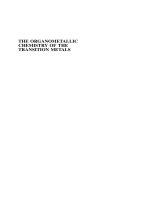The organic chemistry of medicinal agents
Bạn đang xem bản rút gọn của tài liệu. Xem và tải ngay bản đầy đủ của tài liệu tại đây (12.22 MB, 368 trang )
www.pdfgrip.com
Notice
Medicineisanever-changingscience.Asnewresearchandclinical
experiencebroadenourknowledge,changesintreatmentanddrugtherapy
arerequired.Theauthorsandthepublisherofthisworkhavechecked
withsourcesbelievedtobereliableintheireffortstoprovideinformation
thatiscompleteandgenerallyinaccordwiththestandardsacceptedatthe
timeofpublication.However,inviewofthepossibilityofhumanerroror
changesinmedicalsciences,neithertheauthorsnorthepublishernorany
otherpartywhohasbeeninvolvedinthepreparationorpublicationofthis
workwarrantsthattheinformationcontainedhereinisineveryrespect
accurateorcomplete,andtheydisclaimallresponsibilityforanyerrorsor
omissionsorfortheresultsobtainedfromuseoftheinformation
containedinthiswork.Readersareencouragedtoconfirmtheinformation
containedhereinwithothersources.Forexampleandinparticular,readers
areadvisedtochecktheproductinformationsheetincludedinthepackage
ofeachdrugtheyplantoadministertobecertainthattheinformation
containedinthisworkisaccurateandthatchangeshavenotbeenmadein
therecommendeddoseorinthecontraindicationsforadministration.This
recommendationisofparticularimportanceinconnectionwithnewor
infrequentlyuseddrugs.
www.pdfgrip.com
www.pdfgrip.com
Copyright©2016byMcGraw-HillEducation.Allrightsreserved.Exceptas
permittedundertheUnitedStatesCopyrightActof1976,nopartofthis
publicationmaybereproducedordistributedinanyformorbyanymeans,or
storedinadatabaseorretrievalsystem,withoutthepriorwrittenpermissionof
thepublisher,withtheexceptionthattheprogramlistingsmaybeentered,
stored,andexecutedinacomputersystem,buttheymaynotbereproducedfor
publication.
ISBN:978-0-07-179727-6
MHID:0-07-179727-0
ThematerialinthiseBookalsoappearsintheprintversionofthistitle:ISBN:
978-0-07-179421-3,MHID:0-07-179421-2.
eBookconversionbycodeMantra
Version1.0
Alltrademarksaretrademarksoftheirrespectiveowners.Ratherthanputa
trademarksymbolaftereveryoccurrenceofatrademarkedname,weusenames
inaneditorialfashiononly,andtothebenefitofthetrademarkowner,withno
intentionofinfringementofthetrademark.Wheresuchdesignationsappearin
thisbook,theyhavebeenprintedwithinitialcaps.
McGraw-HillEducationeBooksareavailableatspecialquantitydiscountstouse
aspremiumsandsalespromotionsorforuseincorporatetrainingprograms.To
contactarepresentative,pleasevisittheContactUspageat
www.mhprofessional.com.
TERMSOFUSE
ThisisacopyrightedworkandMcGraw-HillEducationanditslicensorsreserve
allrightsinandtothework.Useofthisworkissubjecttotheseterms.Exceptas
permittedundertheCopyrightActof1976andtherighttostoreandretrieveone
copyofthework,youmaynotdecompile,disassemble,reverseengineer,
reproduce,modify,createderivativeworksbasedupon,transmit,distribute,
disseminate,sell,publishorsublicensetheworkoranypartofitwithout
McGraw-HillEducation’spriorconsent.Youmayusetheworkforyourown
noncommercialandpersonaluse;anyotheruseoftheworkisstrictlyprohibited.
Yourrighttousetheworkmaybeterminatedifyoufailtocomplywiththese
terms.
THEWORKISPROVIDED“ASIS.”McGRAW-HILLEDUCATIONAND
ITSLICENSORSMAKENOGUARANTEESORWARRANTIESASTO
www.pdfgrip.com
THEACCURACY,ADEQUACYORCOMPLETENESSOFORRESULTS
TOBEOBTAINEDFROMUSINGTHEWORK,INCLUDINGANY
INFORMATIONTHATCANBEACCESSEDTHROUGHTHEWORKVIA
HYPERLINKOROTHERWISE,ANDEXPRESSLYDISCLAIMANY
WARRANTY,EXPRESSORIMPLIED,INCLUDINGBUTNOTLIMITED
TOIMPLIEDWARRANTIESOFMERCHANTABILITYORFITNESSFOR
APARTICULARPURPOSE.McGraw-HillEducationanditslicensorsdonot
warrantorguaranteethatthefunctionscontainedintheworkwillmeetyour
requirementsorthatitsoperationwillbeuninterruptedorerrorfree.Neither
McGraw-HillEducationnoritslicensorsshallbeliabletoyouoranyoneelsefor
anyinaccuracy,errororomission,regardlessofcause,intheworkorforany
damagesresultingtherefrom.McGraw-HillEducationhasnoresponsibilityfor
thecontentofanyinformationaccessedthroughthework.Underno
circumstancesshallMcGraw-HillEducationand/oritslicensorsbeliableforany
indirect,incidental,special,punitive,consequentialorsimilardamagesthat
resultfromtheuseoforinabilitytousethework,evenifanyofthemhasbeen
advisedofthepossibilityofsuchdamages.Thislimitationofliabilityshallapply
toanyclaimorcausewhatsoeverwhethersuchclaimorcausearisesincontract,
tortorotherwise.
www.pdfgrip.com
Contents
Contributors
Preface
1.TheNatureofBondinginOrganicMolecules
AdamRenslo&DmitryKoltun
Introduction
TheNatureofCovalentandIonicBonds
Box1.1—Drawingorganicmolecules
PolarizationofCovalentBonds
AtomicOrbitalsandValenceBondTheory
HybridizationofOrbitalsandTetrahedralCarbon
HybridOrbitalsofOxygenandNitrogenandCommonFunctionalGroups
Box1.2—Functionalgroupscontainingphosphorusorsulfur
Aromaticity
HeteroaromaticRingSystemsinDrugStructures
Summary
Exercises
2.Non-CovalentInteractions
AdamRenslo
Introduction
EnthalpicandEntropicContributionstoLigand/DrugBinding
TheStrengthofNon-CovalentInteractions
www.pdfgrip.com
DesolvationandtheHydrophobicEffect
IonicInteractions
Box2.1—Ionicinteractionsinaprotonchannelfrominfluenzavirus
HydrogenBonds
C–HBondsasHydrogenBondDonors
ArylRingsasHydrogenBondAcceptors
Box2.2—Aπ-hydrogenbondinglutathioneS-transferase
Aryl-ArylInteractions
Cation-πInteractions
Box2.3—Hydrophobicandcation-πinteractionsinthebindingof
neurotransmittersanddrugs
HalogenBonds
Box2.4—C–Fbondsashydrogenbondacceptorsandinorthogonal
interactionswithcarbonylgroups
Summary
CaseStudy—InhibitorsofFactorXaasAnticoagulants
Exercises
3.Stereochemistry
AdamRenslo
Introduction
ChiralityandtheShapeofMolecules
Stereoisomers—SomeImportantDefinitions
Box3.1—Determiningisomericandstereochemicalrelationshipsbetween
molecules
AvoidingConfusion
Stereoisomersof1,3-Dimethylcyclohexane
ChiralityCenters
AssigningtheConfigurationofChiralityCenters
www.pdfgrip.com
Box3.2—Cahn–Ingold–Prelogrulesinbrief
ConfigurationalAssignmentandStereochemicalRelationships
MesoCompounds
ChiralityCentersatNon-CarbonAtoms
OtherSourcesofChiralityandStereoisomerism
Box3.3—Atropisomerism
Summary
CaseStudy—RacemicandNon-RacemicDrugs
Exercises
4.ConformationsofOrganicMolecules
AdamRenslo
Introduction
NewmanProjectionsandDihedralAngles
ConformationsandEnergiesofEthane—TorsionalStrain
ConformationsandEnergiesofLargerAcyclicMolecules—StericStrain
ConformationsofSmallRings
Box4.1—Thethreemajortypesofstraininorganicmolecules
ConformationsofCyclohexaneandRelatedSix-MemberedRings
EstimatingtheConformationalPreferencesofSubstitutedCyclohexanes
Box4.2—Drawingchairconformations
ConformationallyConstrainedRingSystems
Box4.3—Conformationalconstraintinopiateanalgesics
Summary
CaseStudy—NeuraminidaseInhibitorsandtheInfluenzaVirus
Exercises
5.Acid-BaseChemistryofOrganicMolecules
www.pdfgrip.com
SusanMiller
Introduction
ThreeTheoriesofAcidsandBases
Self-IonizationofWaterandthepHScale
AvoidingConfusion—Useof“Acid”and“Base”andRelatedTerms
TheAcidDissociationConstantKaandpKaasaMeasureofAcidStrength
ElectronegativityandSizeofAtomsandAcid/BaseStrength
AtomHybridizationandAcid/BaseStrength
ResonanceElectronicEffectsonAcid/BaseStrength
InductiveElectronicEffectsofSubstituentsonAcid/BaseStrength
CombinedInductiveandResonanceEffectsonAcid/BaseStrength
ProximityandThrough-SpaceEffectsonAcid/BaseStrength
TheHenderson–HasselbalchRelationshipandAcid/BaseEquilibriaasa
FunctionofpH
Summary
CaseStudy—DiscoveryofTagamet
Exercises
6.NucleophilicSubstitution,Addition,andEliminationReactions
JieJackLi&AdamRenslo
Introduction
Nucleophiles
Electrophiles
Box6.1—Electrophilesincancerdrugs
LeavingGroups
NucleophilicAliphaticSubstitutionReactions—SN2
Box6.2—SN2reactionsinbiologicalchemistry
NucleophilicAliphaticSubstitutionReactions—SN1
www.pdfgrip.com
NeighboringGroupAssistanceinSN1Reactions
NucleophilicAromaticSubstitution—SNAr
AdditionReactions
EliminationReactions—E1andE2
Summary
CaseStudy—DrugsThatFormaCovalentBondtoTheirTarget
Exercises
7.ReactionsofCarbonylSpecies
AdamRenslo
Introduction
NatureoftheCarbonylGroup
RelativeReactivityofCarbonyl-ContainingFunctionalGroups
HydrationofAldehydesandKetones
ReactionsofAldehydesandKetoneswithAlcohols
Box7.1—Glucuronidationinthemetabolismofdrugs
IminesandEnamines
Box7.2—Iminesindrug-proteinconjugates
OximesandHydrazones
ChemicalHydrolysisofEsterandAmideBonds
EnzymaticHydrolysisofPeptideBondsbyProteases
Box7.3—Drugsdesignedtoinhibitproteases
Summary
CaseStudy—Odanacatib
Exercises
8.RadicalChemistry
JohnFlygare&AdamRenslo
www.pdfgrip.com
Introduction
Formation,Stability,andMolecularOrbitalViewofRadicals
RadicalReactions
ReactionsofMolecularOxygen
Iron-MediatedRadicalReactionsinDrugMetabolism
Box8.1—Fentonchemistryintheactionofantimalarialdrugs
Summary
CaseStudy—Calicheamicinγ1
Exercises
SolutionstoExercises
Index
www.pdfgrip.com
Contributors
JohnFlygarehastaughtorco-taughtcoursesinorganicchemistry,
biochemistry,andmedicinalchemistryatStanfordUniversitysince1997,witha
combinedtotalenrollmentofover5,000students.Heisalsoaprojectleaderat
GenentechinSouthSanFranciscowhereheleadsdrugdiscoveryteamsin
diseaseareasincludingoncology,infectiousdiseases,andneurodegeneration.
Severalcompoundsfromtheseprogramsarecurrentlyinhumanclinicaltrials.
HereceivedhisPhDinorganicchemistryfromNorthwesternUniversityand
wasanNIHPostdoctoralFellowatStanfordUniversity.
DmitryKoltunreceivedhisundergraduateeducationatHigherChemical
CollegeoftheRussianAcademyofSciencesandhisPhDdegreefrom
UniversityofMinnesotawithProf.ThomasHoyein1999.Hebeganhiscareer
atMediChemLifeSciencesinChicago,thenmovedtoCVTherapeuticsinPalo
Alto,California.HeiscurrentlyaseniorresearchscientistintheMedicinal
ChemistryDepartmentatGileadSciencesinFosterCity,California.Helivesin
FosterCity,CaliforniawithhiswifeElenaanddaughtersVeraandSonya.
JieJackLiearnedhisPhDinorganicchemistryin1995atIndianaUniversity.
www.pdfgrip.com
AfterapostdoctoralfellowshipatMIT,heworkedasamedicinalchemistat
PfizerandBristol-MyersSquibbfrom1997to2012.Sincethenhehasbeenan
associateprofessorofchemistryattheUniversityofSanFrancisco,teaching
organicandmedicinalchemistry.Hehaspublished23booksforspecialistand
layaudiences,coveringtopicsrangingfromorganicandmedicinalchemistryto
thehistoryofdrugdiscovery.
SusanM.MillerreceivedherPhDinorganicchemistryandmechanistic
enzymologyfromtheUniversityofCaliforniaBerkeley.Afterpostdoctoralwork
inbiologicalchemistryattheUniversityofMichiganinAnnArbor,shejoined
theSchoolofPharmacyattheUniversityofCalifornia,SanFrancisco,in1993
wheresheisnowprofessorofpharmaceuticalchemistry.Herresearchinterests
liebroadlyinmechanisticandstructure/functionstudiesofredoxenzymesand
enzymesinvolvedinbiosyntheticpathwaysforantimicrobials.Sheteaches
aspectsofmechanisticorganicchemistryandenzymologyinbothprofessional
pharmacyandgraduatechemistryandbiophysicsprograms.
AdamRensloearnedaBAinchemistryfromSt.OlafCollegein1993anda
PhDinorganicchemistryfromMassachusettsInstituteofTechnologyin1998.
AfterpostdoctoralstudiesattheScrippsResearchInstitute,heworkedasa
medicinalchemistinthepharmaceuticalindustryfor6years.In2006hejoined
thefacultyintheDepartmentofPharmaceuticalChemistryattheUniversityof
California,SanFrancisco.Hisresearchinterestsincludethedevelopmentofnew
approachesfortargeteddrugdeliveryininfectiousdiseaseandcancer.He
teachessyntheticorganicandmedicinalchemistryinboththeprofessional
pharmacyandgraduatechemistryandchemicalbiologyprograms.
www.pdfgrip.com
Preface
Thechemistryofcarbon-basedmolecules—theirstructures,intermolecular
interactions,andreactivity—underlieslifeasweknowitandthusalsothe
beneficial(andsometimesundesired)effectsofthemedicinesweuse.Thefact
thatrathersimpleorganicmoleculescanbeprofoundlyeffectiveintreating
humandiseaseinallitscomplexitymustrankamongthemostsignificant
findingsofmedicineandbasicscience.Formanystudents,thisrealization
fomentsadesiretopursueacareerinoneofthevariousfieldsrelatedtothe
discovery,study,orappropriateadministrationofmedicines.Inmyowncase,
thismeantembarkingonthestudyoforganicchemistryandlearninghowto
synthesizeorganicmoleculesinthelaboratory.Later,asamedicinalchemist
workinginthepharmaceuticalindustry,Iexperiencedthethrillofseeingafew
milligrams(merespecks!)ofanewlysynthesizedcompoundcureanotherwise
lethalinfectioninamouse.Afewsuchcompoundswouldlaterbedestinedfor
studiesinhumanpatients,beginningthelongandoftenperilouspathtowardthe
approvalofanewdrug.
Thistextbookisinformedbymyexperiencesasapracticingmedicinal
chemistandasaneducatorofpharmacystudentsattheUniversityofCalifornia,
SanFrancisco.Initsorganizationandcontent,thetextislargelybasedona
semester-longcourseinorganicchemistrytaughttofirst-yearPharmDstudents
atUCSF.Itisintendedasateachingtextbook,acompanionforstudentsof
pharmacyormedicinalchemistry,thatcanbecoveredinitsentiretyinasingle
semester.Giventhis,thetextisnecessarilylimitedinitsscopeandisnot
intendedtoreplaceanyoftheexcellentandcomprehensivehandbooksof
medicinalandpharmaceuticalchemistrythatareavailable.Whatiscoveredhere
arethosetopicswehavefoundmostrelevantandinstructiveinproviding
studentsofpharmacywithasolidgroundinginorganicchemistryasitrelatesto
drugstructureandaction.
Thefirstfourchaptersofthetextcoverthefundamentalsofdrugstructure
andbinding—thenatureofthechemicalbondsindrugstructure,thetypesof
non-covalentintermolecularinteractionsdrugsformwiththeirtargets,andtheir
three-dimensionalshapeandconformations.Thefinalfourchaptersare
www.pdfgrip.com
concernedwithchemicalreactivityrelevanttodrugaction—thereactivityof
(some)drugstowardtheirtargets,themetabolismofnearlyalldrugs,andthe
reactionscarriedoutbytheenzymesthatmodifydrugsorcanbetargetedby
them.Throughoutthetext,thediscussionisintertwinedwithillustrative
examplesofdrugsynthesis,action,ormetabolism.Also,eachchapterconcludes
withadrug“casestudy”selectedtoemphasizeandreinforcetheconcepts
introducedinthatchapter.
Iamindebtedtoanumberofindividualswithoutwhomthisprojectcould
neverhavehappened.Ithasbeenadistinctprivilegetointeractwiththebright
andinquisitivePharmDstudentsthatUCSFisfortunateenoughtoattract.Their
willingfeedbackastowhatisandisnotworkingintheclassroomhasshaped
howweteachorganicchemistryatUCSF,andthisinturnisreflectedinthefinal
formofthebook.ImustlikewiseacknowledgecurrentandformerUCSF
colleagues(SusanM.Miller,ThomasScanlan,andPaulOrtizdeMontellano)
whocontributedtodevelopingtheorganicchemistrycurriculuminthePharmD
program.TheeditorsandproductiondesignersatMcGraw-HillEducationhave
beenapleasuretoworkwith.IwouldespeciallyliketothankMichaelWeitz,
PeterBoyle,andRuchikaAbrolfortheirassistanceandencouragement.Iam
gratefultoProfessorPeterBeak(UniversityofIllinoisatUrbana-Champaign)
forreadingthefinalmanuscript.Lastbutnotleast,Imustthankmycoauthors
andcontributors(JohnFlygare,DmitryKoltun,JieJackLi,andSusanM.
Miller),top-notchresearchersandeducatorswhoputtheirownstamponthe
chapterstowhichtheycontributed.WehopethatthisfirsteditionofThe
OrganicChemistryofMedicinalAgentswillproveusefulforstudentsand
instructorsalikeandwewelcomesuggestionsforimprovementsandadditionsto
futureeditions.
AdamRenslo
www.pdfgrip.com
Chapter1
TheNatureofBondinginOrganic
Molecules
AdamRenslo&DmitryKoltun
CHAPTEROUTLINE
1.1Introduction
1.2TheNatureofCovalentandIonicBonds
Box1.1—Drawingorganicmolecules
1.3PolarizationofCovalentBonds
1.4AtomicOrbitalsandValenceBondTheory
1.5HybridizationofOrbitalsandTetrahedralCarbon
1.6HybridOrbitalsofOxygenandNitrogenandCommonFunctionalGroups
Box1.2—FunctionalgroupscontainingPhosphorusorSulfur
1.7Aromaticity
1.8HeteroaromaticRingSystemsinDrugStructures
1.9Summary
1.10Exercises
1.1Introduction
Inthischapter,wewillreviewfundamentalconceptsofchemicalstructureand
bondingintheorganicmoleculesthatmakeupdrugsandtheirbiologicaltargets.
By“organic,”wemeanmoleculesthatareconstructedprimarilyfromthe
elementcarbon(C).Carbonexhibitsstrikingversatilityinitsabilitytoform
variousdifferentbondingarrangementswithothercarbonatomsaswellaswith
otherbiologicallyrelevantelementssuchasnitrogen(N),oxygen(O),sulfur(S),
andphosphorus(P).Itisthisversatilitythatallowedcarbon-basedlifetoemerge
onourplanet.Thus,tounderstandthemoleculesoflife—proteins,lipids,nucleic
www.pdfgrip.com
acids,hormones,etc.—andthedrugsthatinteractwiththem,wemuststartwith
asolidunderstandingofstructureandbondinginorganicmolecules.Inthis
chapter,wewillbeginbycontrastingthenatureofionicandcovalentbonding
andwilldescribethepolarizationofcovalentbonds.Wewillthendivedeeper
intothenatureofthecovalentbond,discussingatomicandmolecularorbitals,
the“hybridization”oforbitals,andaromaticity.Finally,wewillreviewsome
importantfunctionalgroupsandorganicringsystemsthatfigureprominentlyin
thestructuresofbiologicalmoleculesanddrugs.
Inthechaptersthatfollowwewilllearnmoreabouttheintermolecular
interactions,mostlynon-covalent,thatgovernthebindingofadrugmoleculeto
itsintended(andsometimesunintended)biologicaltargets.Fornow,itis
importanttorecognizethatadrugmolecule’sparticularstructure—itsshapeand
thenatureandconnectivityofitsatoms—determineswhatbiologicalactivitiesit
willhave.Ifamolecule’sstructureleadstointeractionsinthebodythatcorrect
anabnormality,restorenormalfunctionofacell,orkillapathogenicor
cancerouscell,anewmedicineisborn.Theseeminglyendlesswaysinwhich
organicmoleculescanbeassembledhasallowedscientiststocreateourcurrent
pharmacopeiaandaffordsconfidencethatstillmorenewmedicineswillbe
developedtoaddresscurrentlyunmetmedicalneeds.
1.2TheNatureofCovalentandIonicBonds
Atomsarecomprisedofanucleuscontainingpositivelychargedprotonsand
unchargedneutronssurroundedbynegativelychargedelectrons.Onaccountof
theirverylowmass,electronsbehaveasbothparticlesandwaves.Thepeculiar
wave-likenatureoftheelectroniswhatpreventsthisnegativelychargedparticle
fromsimply“falling”intothepositivelychargednucleus,towhichitisclearly
attracted.Wave-likeelectronsarespatiallyconfinedtospecificatomic“orbitals”
surroundingthenucleus.Whileatomicandmolecularorbitals(Sections1.4and
1.5)underlieourcurrentunderstandingofchemicalbonding,theirexistencewas
hintedatmuchearlierbyacertainperiodicityinthechemicalreactivityofthe
elements.ItwasthisobservationthatallowedMendeleevtoconstructhis
periodictableoftheelements.Apartialperiodictableincludingjustthefirst
three“periods”(rows)ofelementsmostrelevanttoorganicchemistryis
providedhere(Figure1.1).
www.pdfgrip.com
Figure1.1Periodictableofthefirst18elements(atomicnumberZ=1through18).Groups(columns)1–8
representthe“maingroup”elementsandaretheelementsmostrelevanttoorganicchemistryanddrug
structures.Electronicconfigurationsareprovidedincondensedformat,withconfigurationofvalence
electronsshownexplicitlyandinnersphereelectronsindicatedbythecorrespondingnoblegas
configuration,either[He]or[Ne].
Theperiodictablearrangestheelementsinorderofincreasingnumberof
protons(atomicnumber,Z)andby“groups”(columns)ofelementswithsimilar
chemicalreactivity.Thisperiodicityledtoanunderstandingofchemical
reactivityandbondingasbeingrelatedtothefillingofelectron“shells”
surroundingthenucleus.Tounderstandwhychemicalbondsformatall,itis
usefultoconsiderthosefewelementsthatgenerallydonotformbonds—the
noblegases.Foundatthefarright-handsideoftheperiodictable,noblegases
suchashelium(He),neon(Ne),andargon(Ar)are“noblyunreactive”because
theiroutermostelectronshellisperfectlyfilled.Ifheliumrequiresonlytwo
electronstocompleteitsoutermostshell,thenneonandargonrequirean
additional8and16electrons,respectively,todoso.Thedrivingforcefor
chemicalbondingcanthusbeunderstoodasadesireofatomstoachieve
perfectlyfilledelectronshells(anoblegas“configuration”)byformingbondsto
otheratoms.Thiscanbeachievedinoneoftwoways—bytheexchangeof
electronsinanionicbondorbythesharingofelectronsinacovalentbond.
Thechemistryofcarboninvolvescovalentbondingandsowewilldiscuss
ionicbondingonlybrieflyhere.Commontablesalt(sodiumchloride,Na+Cl−)
providesthemostfamiliarexampleofanionicbondbetweentwoatoms.
Lookingattheperiodictableweseethatbothsodiumandchlorinearejustone
columnaway(andthusoneelectronaway)fromanoblegasconfiguration.
Transferofanelectronfromsodiumtochlorineproducesasodiumcation(Na+)
andchlorideanion(Cl−),eachwiththeelectronicconfigurationofneon(i.e.,a
www.pdfgrip.com
filledouterelectronshell).The“bond”inNa+Cl−canbethoughtofasthe
electrostaticattractionbetweenthesodiumandchlorideions.Thebenign,
unreactivenatureofNa+Cl−canbecontrastedwithelementalsodiummetal
(Na),whichreactsviolentlywithwater,andelementalchlorinegas(diatomic
Cl2),whichwasusedasawarfareagentinWorldWarI.
Carbondoesnotformionicbondsbecauseachievinganoblegas
configurationwouldrequirethatitacquireandstabilizefouradditional
electrons,resultinginatetra-anionwithanoverallchargeof−4.Smallatoms
suchasC,N,andOarenotcapableofexistinginsuchhighlychargedstates.
Instead,carbonachievesanoblegasconfigurationbyformingfourcovalent
bonds.Eachbondcomprisestwoelectrons,oneprovidedbythecarbonatomand
oneprovidedbyitsbondingpartner.Withfourbondsoftwoelectronseach,a
carbonatomhasobtainedtheeightelectrons(anoctet)requiredtoexactlyfillits
outermostelectronshell.Whilewecommonlyshownbondsassimplelines,the
chemistGilbertN.Lewisdevelopedanotationinwhichabondisshownasa
pairofdots,meanttorepresentthepairofsharedelectronsthatmakeupthe
bond.Lewisstructurescanbeusedtoshownotonlysinglebondsbutalso
doubleandtriplebonds,asillustrated(Figure1.2).Whilethisnotationhasclear
limitationsfordrawinglargermolecules,westilluseLewisnotationtoshowand
keeptrackofnonbondedlonepairelectrons.
Figure1.2Ethane,ethylene,andacetyleneshownasLewisdrawingsandaslinedrawings.
Sincecarbonmustformfourbondstoachieveanoblegasconfiguration,we
saythatcarbonhasavalenceoffour.Byinspectingtheperiodictable(Figure
1.1),wecanfurthermorepredictthatnitrogenshouldhaveavalenceofthreeand
oxygenavalenceoftwo,sincenitrogenandoxygenwillrequirethreeortwo
additionalsharedelectrons,respectively,toachieveanoblegasconfiguration.
Hydrogenisonlyonecolumnremovedfromheliuminthefirstrowofthe
www.pdfgrip.com
periodictableandsoithasavalenceofone.Similarly,thehalogens(Cl,Br,I)
haveavalenceofonesincethisgroup(column)isimmediatelyadjacenttothe
noblegassesandthusisjustonesharedelectronawayfromafilledshell.
Evenwiththisrathercrudenotionoffillingelectron“shells,”wecanalready
makesenseofagreatvarietyoforganiccompoundsformedfromcombinations
ofC,N,O,andH.Somebiologicallyrelevantmoleculesareshown(Figure1.3)
usingLewisstructurestoillustratebondingandthefillingofelectronshellsfor
H(twoelectronsrequired)andC,N,andOatoms(eightelectronsrequired).
Notethatallthebondingandnonbondingelectronsassociatedwithagivenatom
counttowardthetotalsharedelectroncount.Thusthetriplebondinhydrogen
cyanide(HCN)contributessixsharedelectronstoboththeCandNatoms.
Thesesixelectrons,whencombinedwithapairofelectronsintheH–Cbond
andthenonbondedelectronpaironthenitrogenatom,produceatotalelectron
countofeightforbothCandN(Figure1.3).
Figure1.3StructuresofsimpleorganicmoleculesshownaslinedrawingsandcompleteLewisstructures.
It’sagoodideatobecomeproficientindrawingLewisstructuresasthis
approachhelpsusunderstandthelocationsofbondedandnonbondedelectrons
andreinforcestheideathatbondsarecomprisedofpairsofsharedelectrons.Of
course,usingLewisstructuresfordrug-sizedmoleculesisnotpracticalandso
chemistshavedevelopedshort-handnotationsfordrawingchemicalstructures.
ThesearereviewedinBox1.1andthisstandardnotationwillbeusedthroughout
mostofthistext.
Box1.1Drawingorganicmolecules.
www.pdfgrip.com
Chemistshaveadoptedadrawingconventionthatavoidstheneedtoexplicitly
showhydrogenatomsorevenwritea“C”foreachcarbonatom.Acarbon
atomisimplicitateach“joint”inastructure,oratanunlabeledterminus.
Hydrogenatomsaresimilarlyimplicit—eachcarbonisassumedtocontainas
manyboundhydrogensasnecessarytoachievetetravalency.Atomsotherthan
carbonandhydrogenareshownexplicitly,asarehydrogenatomsonnoncarbonatoms(e.g.,thehydroxylgroup–OHin1-butanol).Itisalsohelpfulto
showhydrogenatomsexplicitlyoncertainfunctionalgroupssuchas
aldehydes.Commonaromaticringslikephenylandpyridinearebestdepicted
withalternatingdoubleandsinglebonds.
www.pdfgrip.com
1.3PolarizationofCovalentBonds
Inourdiscussionofcovalentbondingintheprevioussection,wedescribedthe
electronsinvolvedinacovalentbondasbeingsharedbetweenthetwoatoms
involvedinthebond.Ifthebondedatomsareidenticalthentheelectronsinthat
bondwillindeedbesharedequally.However,whentwodifferentatomsforma
covalentbond,theelectronsinthebondwillusuallynotbesharedequally
betweenthebondedatomsandthebondissaidtobepolarized.Polarizationof
covalentbondsoccursbecausecertainatomshavemorepowertopullelectrons
towardtheirnucleusthanothers.Generally,atomslocatedfurthertotherightin
aperiod(row)oftheperiodictableexertastrongerpullonelectronsandaresaid
tobemoreelectronegative.Fluorineforexampleismoreelectronegativethan
carbon,andoxygenismoreelectronegativethannitrogen.Wecanillustratethe
polarizationofaC–Fbondinoneoftwoways,asshownbelow.Theδ+
nomenclatureindicatesapartialpositivechargeandtheδ−aregionofpartial
negativecharge.ThispolarizationoftheC–Fbond(withgreaterelectrondensity
onfluorine)canalsobeillustratedusingthespecialarrowshownbelowatright.
Bothofthesenotationswillbeusedinsubsequentsectionsandchaptersofthis
text.
www.pdfgrip.com
Toafirstapproximation,wecanestimateelectronegativityusingtheconcept
ofeffectivecharge,whichisequaltothetotalpositivechargeofthenucleus
minusthenegativechargeofthenon-valence(“innershell”)electrons.For
example,lithium(Li)hasanatomicnumberofthree(Z=3),andthusthree
protonsinthenucleusandanuclearchargeof+3.Lithiumhasasinglevalence
electronandtwoinnershellelectronssotheeffectivechargeoflithiumis+1(3
−2=1).Beinginthesamerowoftheperiodictableaslithium,fluorinealsohas
onlytwoinnershellelectrons.Withanatomicnumber9however,fluorinehas
aneffectivechargeof+7(9−2=7).Thus,ifonenegativelychargedelectronof
Liisexperiencingthepullofasinglepositivechargefromthenucleus,an
electronfromFisexperiencingapullthatisseventimesgreater.
Effectivechargeisusefulforestimatingrelativeelectronegativityfor
elementsinthesameperiod(row)oftheperiodictable,butitislesspredictive
whencomparingatomsfromdifferentperiodsanddifferentgroups,likesulfur
andnitrogen.Inthesecases,thePaulingelectronegativityscalebecomes
indispensable.DevisedbyLinusPauling,thetableassignseachatoman
electronegativitycoefficient,andthecovalentbondisalwayspolarizedinthe
directionofanatomwithalargercoefficient(Table1.1).FromthePauling
electronegativityscaleweseethatnitrogen(Paulingcoefficientof3.0)ismore
electronegativethansulfur(2.5).Wewillfrequentlyrefertotheelectronegativity
scaleinsubsequentchaptersasthisconceptisverypowerfulinhelpingto
understandchemicalreactivityandintermolecularinteractionsoffunctional
groups.
Table1.1PaulingElectronegativityScaleforSelectedElementsMost
RelevanttoOrganicChemistryandDrugAction.
www.pdfgrip.com
1.4AtomicOrbitalsandValenceBondTheory
TheconceptofvalenceandtheLewisviewofcovalentbondingisusefultohelp
usunderstandwhyelementslikeH,C,N,andOcombineinvariouswaysin
organicmolecules.Unfortunately,thisviewfailstoexplainmanyother
importantfeaturesoforganicmolecules,suchasthethree-dimensional
arrangementofbondsandthefactthatrotationaboutC–Csinglebondsis
generallyfacilewhilerotationaboutC–Cdoubleortriplebondsisnot.Inthis
sectionwewillintroducetheconceptoftheatomicorbitalaswellasvalence
bondtheory,inwhichcovalentbondsareunderstoodasarisingfromthe
“overlap”ofatomicorbitalstoformmolecularorbitals.Atleastnotionally,the
overlapofatomicorbitalstoformbondscanbeequatedwiththesharingof
electronsaspositedintheLewisdescriptionofthecovalentbond.
Quantummechanicsisthefieldofphysicsthatdealswithmatterandenergy
atverysmallscales,wherethedualwave-particlenatureofmatterbecomes
important.Accordingtoquantummechanics,electronsdonotcirclethenucleus
inafixedorbitlikeaplanetarounditssun,butratherare“spreadout”inthreedimensionalspacearoundthenucleusasdefinedbyspecificsolutionstothe
Schrödingerequation.
Hψ=Eψ
www.pdfgrip.com
Eachsolutiontothisequationisassociatedwithaparticularwavefunction
(ψ),alsocalledanatomicorbital.Theeasiestwaytovisualizeanatomicorbital
istoconsideritsprobabilitydensity,thesquareofthewavefunction(ψ2),which
correspondstotheprobabilitythatanelectronwillbefoundinaparticular
regionofspacesurroundingthenucleus.Thelowestenergyatomicorbitalfor
thehydrogenatom(andbyextensionallotheratoms)isthe1sorbital,whichhas
asphericalprobabilitydensity(Figure1.4)andcanaccommodateatmosttwo
electrons,providedtheyhaveopposite“spin”asdictatedbythePauliexclusion
principle.Thefillingofa1sorbitalwithtwoelectronsisthemoreaccurate
pictureofwhatisgoingonwithHeanditsfilledelectron“shell.”Nexthighest
inenergyisthe2sorbital,whichisalsosphericalbutwithitselectrons,on
average,spendingmoretimefurtherfromthenucleus.Nexthigherinenergyare
threeenergeticallyequivalent2porbitals,oftendenoted2px,2py,and2pz.Thep
orbitalhasabilobedor“dumbbell”shapedprobabilitydensity,withanodeof
zeroprobabilityatthenucleus,wherethewavefunctionchangessign.Thethree
porbitalsareorientedalongdifferentaxeswhenshownonatypicalcoordinate
system(Figure1.5).Each2porbitalcanaccommodateuptotwospin-paired
electrons,foratotalofsix2pelectrons.
Figure1.4Boundarysurfaceof1sand2satomicorbitals.Thesphericalsurfacesshownrepresentthe
boundarywithinwhichtheprobabilityoffindinganelectronishigh(>90%).(Reproduced,with
permission,fromCareyFA,GiulianoRM.OrganicChemistry.9thed.NewYork:McGraw-HillEducation;
2014.)









